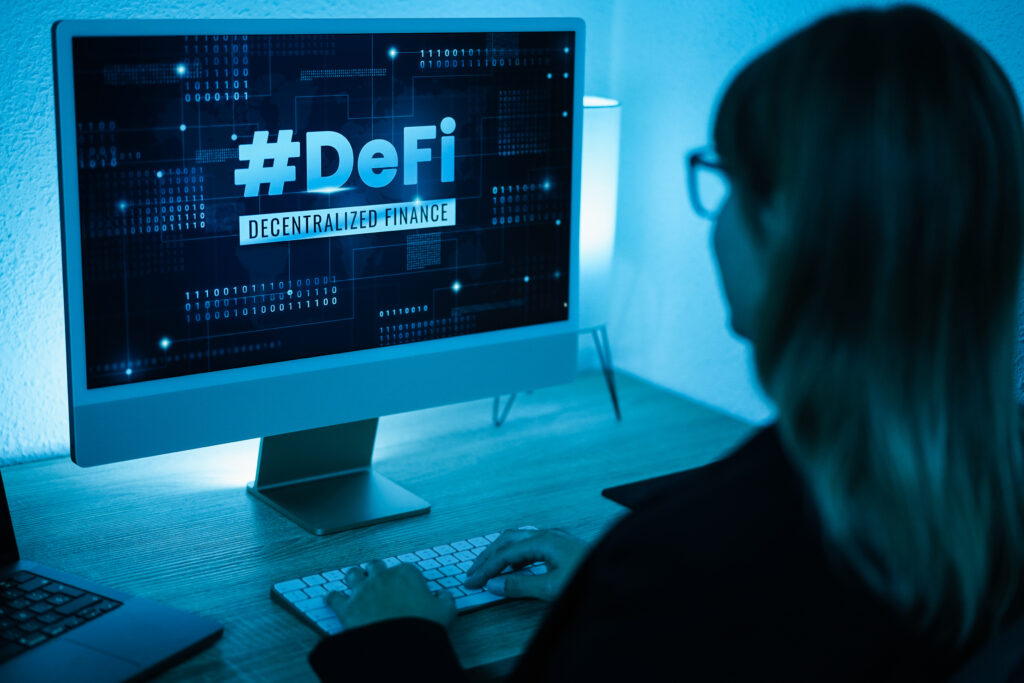We are going to explore the top 5 DeFi projects that have gained prominence in the decentralized finance ecosystem:
Top 5 DeFi projects
- Uniswap (UNI): Uniswap is a leading decentralized exchange (DEX) built on the Ethereum blockchain. It utilizes an automated market maker (AMM) model to facilitate peer-to-peer trading of various ERC-20 tokens, allowing users to trade without traditional intermediaries.
- Aave (AAVE): Aave is a decentralized lending and borrowing platform that enables users to lend their crypto assets and earn interest, as well as borrow assets by providing collateral. AAVE holders also participate in the platform’s governance through voting.
- Compound (COMP): Compound is another DeFi lending platform that offers users the ability to lend and borrow various cryptocurrencies. Users can earn interest on their deposited assets while borrowers can access funds by providing collateral.
- MakerDAO (MKR): MakerDAO is the protocol behind the stablecoin Dai (DAI). It enables users to generate DAI by locking up collateral (often Ether) in a smart contract. MKR token holders participate in the governance and risk management of the system.
- Synthetix (SNX): Synthetix is a DeFi project that enables the creation and trading of synthetic assets (synths) that track the value of real-world assets. It allows users to gain exposure to a wide range of assets without directly owning them.
These are just a few examples of the top projects which have made it top 5 defi projects status. The projects have demonstrated innovative solutions in the realm of decentralized finance. It’s important to conduct thorough research before participating in any project and to stay informed about the constantly evolving DeFi landscape.

Uniswap (UNI):
1st on our top 5 Defi projects is UNI. In the rapidly evolving landscape of decentralized finance (DeFi), few projects have captured the imagination and potential for transformative change quite like Uniswap. As a pioneering decentralized exchange (DEX) built on the Ethereum blockchain, Uniswap has reshaped the way users trade cryptocurrencies, offering an automated and trustless platform that empowers individuals like never before. In this comprehensive article, we delve deep into the intricacies of Uniswap (UNI), exploring its origins, mechanisms, impact on the DeFi ecosystem, and what the future might hold.
Origins and Genesis of Uniswap
Uniswap was conceived in 2018 by Hayden Adams, who sought to address the limitations of traditional centralized exchanges by creating a DEX that eliminates the need for intermediaries and custodial control. The project gained significant attention and funding, culminating in the launch of its first iteration in November 2018.
Automated Market Maker (AMM) Model
At the heart of Uniswap’s innovation is its Automated Market Maker (AMM) model. Unlike traditional order book exchanges, Uniswap relies on liquidity pools and smart contracts to facilitate trading. Users can become liquidity providers by depositing pairs of tokens into these pools, which are then used to enable decentralized trading.
The AMM model allows anyone to become a liquidity provider, earning a share of the transaction fees generated by the protocol. This has democratized liquidity provisioning and enabled users to passively earn rewards.
Decentralization and Trustlessness
Uniswap’s architecture embodies the principles of decentralization and trustlessness that underpin the DeFi movement. Trades occur directly between users’ wallets, eliminating the need for intermediaries to hold funds. The use of smart contracts ensures that trades are executed as intended without relying on a centralized authority.
UNI Token and Governance
In September 2020, Uniswap made a significant move by launching its native governance token, UNI. Distributed to historic users and liquidity providers, UNI grants holders the power to influence the protocol’s future development and governance decisions. This innovative approach to decentralized governance has set a precedent for other DeFi projects.
Impact on the DeFi Landscape
Uniswap’s impact on the DeFi landscape has been profound. Its user-friendly interface and liquidity provision model have attracted a diverse community of traders, liquidity providers, and developers. Uniswap’s success has also paved the way for the proliferation of other DEXs and AMM-based protocols.
However, Uniswap has not been without challenges. The AMM model’s susceptibility to impermanent loss, as well as concerns about front-running and gas fees on the Ethereum network, have prompted discussions about potential solutions and improvements.
The Future of Uniswap and DeFi
As DeFi continues to evolve, Uniswap remains at the forefront of innovation. The upcoming Ethereum 2.0 upgrade, with its promise of scalability and reduced gas fees, could enhance Uniswap’s efficiency. Additionally, the protocol’s ongoing development and governance evolution via UNI tokens suggest a dynamic and community-driven path ahead.
In conclusion, Uniswap stands as a beacon of innovation in the DeFi landscape, exemplifying the potential of decentralized exchanges and user-driven finance. Its AMM model and emphasis on trustless trading have opened new avenues for users to participate in the burgeoning DeFi ecosystem. As the DeFi movement gains momentum, Uniswap’s influence is set to play a pivotal role in shaping the financial landscape of the future.
Aave (AAVE):
Another top 5 defi project that is Redefining DeFi Lending and Borrowing for a New Era
In the dynamic realm of decentralized finance (DeFi), one project has emerged as a frontrunner in revolutionizing the way users lend, borrow, and interact with cryptocurrencies: Aave. By offering a sophisticated lending and borrowing platform built on blockchain technology, Aave has transformed traditional financial systems, providing users with unprecedented control over their assets and paving the way for a new era of decentralized finance. In this comprehensive article, we explore the intricacies of Aave (AAVE), from its inception to its impact on the DeFi landscape and its potential to reshape the future of lending.
Origins and Evolution
The story of Aave begins with its founder, Stani Kulechov, who sought to create a platform that addressed the limitations and inefficiencies of traditional lending and borrowing systems. Launched in 2017 as ETHLend, the project rebranded to Aave in 2018, embracing the Finnish word for “ghost” as a nod to the project’s mission of leaving behind traditional finance systems.
Lending and Borrowing on Aave
At its core, Aave is a DeFi protocol that allows users to lend their cryptocurrency assets to the platform’s liquidity pools and earn interest in return. Conversely, users can also borrow assets by providing collateral. This innovative approach to lending and borrowing removes the need for intermediaries, enabling direct peer-to-peer interactions.
Aave stands out with its “flash loans,” a unique feature that allows users to borrow assets without collateral as long as the loan is repaid within the same transaction. This has opened the door to new possibilities, such as arbitrage and complex trading strategies, while also raising discussions about the potential risks and benefits.
Overcollateralization and Liquidation
One of the key principles of Aave’s lending and borrowing mechanism is overcollateralization. Users must provide collateral that exceeds the value of the assets they borrow, reducing the risk of default. In cases of price volatility or undercollateralization, Aave’s automated liquidation mechanisms ensure the system remains solvent.
The AAVE Token and Governance
The AAVE token plays a pivotal role in Aave’s ecosystem. Holders of AAVE tokens can participate in governance decisions, suggesting and voting on proposals that impact the protocol’s development and parameters. This introduces a new level of decentralization and community involvement in shaping Aave’s future.
Impact on DeFi and Beyond
Aave’s innovative approach to lending and borrowing has reverberated throughout the DeFi landscape. Its user-friendly interface, robust security measures, and sustainable economic model have attracted a growing community of users, developers, and investors. Aave’s success has not only solidified its place in DeFi but has also inspired other projects to explore novel ways of utilizing blockchain technology for financial services.
Challenges and Future Development
While Aave has achieved remarkable success, challenges such as regulatory considerations, scalability concerns, and mitigating risks associated with flash loans remain. The Aave team continues to work on enhancing the protocol’s efficiency, security, and user experience, with plans to transition to Ethereum’s Layer 2 solutions to address scalability.
Conclusion: Aave’s Legacy in DeFi
As the DeFi movement continues to gather momentum, Aave’s impact on reshaping lending and borrowing is undeniable. By providing users with accessible, efficient, and decentralized financial services, Aave has set a precedent for how blockchain technology can transform traditional finance. With ongoing development, innovative features, and a strong community backing, Aave’s legacy is poised to leave an indelible mark on the future of decentralized finance and beyond.
Compound (COMP):
One of the top 5 defi projects transforming Lending and Borrowing in the DeFi Landscape,
In the ever-evolving world of decentralized finance (DeFi), Compound (COMP) stands as a trailblazing project that has redefined lending and borrowing paradigms on the blockchain. With its innovative approach to interest generation, automated mechanisms, and governance structures, Compound has emerged as a cornerstone of the DeFi ecosystem. In this comprehensive article, we delve into the intricacies of Compound, exploring its genesis, mechanisms, impact on DeFi, and the potential it holds for reshaping the financial landscape.
Origins and Genesis
Compound was founded by Robert Leshner and Geoff Hayes in 2017 with the mission of creating an open and permissionless protocol for lending and borrowing digital assets. The platform’s launch in 2018 marked the beginning of its journey to revolutionize the traditional financial services landscape by leveraging the power of blockchain technology.
Decentralized Lending and Borrowing
At its core, Compound offers users the ability to lend their cryptocurrencies and earn interest, as well as to borrow assets by collateralizing their holdings. This unique approach to lending and borrowing operates entirely on the blockchain through smart contracts. Users can lend and borrow a wide range of supported tokens, earning interest in real-time without intermediaries.
Interest Generation Mechanism
Compound employs an algorithmic interest rate model that automatically adjusts the interest rates based on the supply and demand of each supported asset. As the supply of an asset increases, the interest rate for borrowing that asset rises, incentivizing lenders and borrowers to reach equilibrium.
Governance and COMP Token
One of the standout features of Compound is its governance structure, facilitated by the COMP token. Launched in June 2020, the COMP token enables holders to participate in protocol governance. This includes proposing and voting on changes to the protocol’s parameters and improvements. The introduction of decentralized governance through COMP has democratized decision-making and community involvement in shaping the platform’s future.
Impact on DeFi Ecosystem
Compound’s influence on the DeFi ecosystem has been profound. Its transparent, permissionless, and trustless nature has attracted a global community of users, developers, and enthusiasts. By offering an alternative to traditional financial systems, Compound has paved the way for a new era of financial services that prioritize accessibility and inclusivity.
Challenges and Continuous Innovation
While Compound has achieved remarkable success, it has not been without its challenges. Smart contract vulnerabilities and the risks associated with over-collateralization and under-collateralization remain areas of concern. The project’s development team continues to work diligently to address these issues and enhance the protocol’s security.
Future Prospects
As the DeFi landscape continues to evolve, Compound’s future prospects remain bright. The team’s commitment to continuous innovation, coupled with the community’s engagement, positions the protocol for further growth. Moreover, Compound’s influence extends beyond the DeFi sector, inspiring other projects to explore novel financial solutions on the blockchain.
Conclusion: Compound’s Legacy in DeFi
In the grand tapestry of DeFi, Compound has woven a thread of innovation that continues to shape the financial landscape. Its automated interest mechanism, decentralized governance, and commitment to open financial access have set a precedent for how blockchain technology can transform lending, borrowing, and decision-making. As the DeFi movement gathers momentum, Compound’s legacy is destined to be etched in the foundation of decentralized finance, serving as an emblem of empowerment, transparency, and the limitless potential of blockchain technology.
MakerDAO (MKR):
MakerDAO is one of the originals, it makes in the top 5 defi projects. Pioneering Stability and Decentralized Finance on the Blockchain
In the realm of decentralized finance (DeFi), MakerDAO (MKR) stands as a true pioneer, reshaping traditional financial systems through its innovative approach to stablecoin creation and governance. With a mission to introduce stability and inclusivity to the blockchain landscape, MakerDAO has become a cornerstone of the DeFi movement. In this comprehensive article, we explore the origins, mechanisms, impact, and potential future of MakerDAO, shedding light on how it’s shaping the future of finance.
Genesis and Inception
The story of MakerDAO began in 2015, when Rune Christensen envisioned a decentralized stablecoin system that could provide a reliable and trustless store of value in the blockchain space. Launched in 2017, MakerDAO aimed to address the volatility of cryptocurrencies and pave the way for a decentralized financial ecosystem.
Stablecoin Creation through Collateralization
At the heart of MakerDAO’s innovation is the creation of the Dai stablecoin. Unlike traditional cryptocurrencies that experience price volatility, Dai is designed to maintain a stable value pegged to a specific currency, such as the US Dollar. This stability is achieved through a collateralization mechanism, where users lock up assets like Ether (ETH) in smart contracts to generate Dai. These smart contracts, called Collateralized Debt Positions (CDPs), ensure that the value of locked assets exceeds the value of the generated Dai, reducing the risk of under-collateralization.
Decentralized Governance and MKR Token
MakerDAO’s governance structure, powered by the MKR token, empowers users to collectively make decisions about the protocol’s parameters, stability fees, and risk management strategies. MKR token holders have the responsibility of ensuring the system’s stability by participating in voting and risk management processes. In the event of insolvency, MKR tokens are used to cover deficits and stabilize the system, further incentivizing community involvement in maintaining Dai’s stability.
Dai: Empowering DeFi Ecosystem
The creation of Dai has had a transformative impact on the DeFi ecosystem. With Dai, users have access to a stable medium of exchange, enabling them to hedge against market volatility without relying on traditional fiat-backed stablecoins. This has driven the adoption of Dai across various DeFi platforms, including lending, trading, and yield farming.
Challenges and Evolving Landscape
While MakerDAO has been a trailblazer, it hasn’t been without challenges. The intricate balance between stability, collateralization, and decentralized governance requires careful management. Smart contract vulnerabilities, as well as the potential impact of major price fluctuations on collateralized assets, remain areas of concern. The development team continuously works to address these challenges and improve the system’s security.
Future Prospects
As DeFi continues to gain momentum, MakerDAO’s role remains significant. The integration of Dai into various DeFi protocols and applications is set to expand its use cases. Furthermore, MakerDAO’s pioneering concepts have inspired similar projects aiming to introduce stability and decentralized governance into the broader financial ecosystem.
Conclusion: MakerDAO’s Enduring Legacy
MakerDAO has established itself as a cornerstone of decentralized finance, embodying the principles of stability, decentralization, and inclusivity. By creating Dai and pioneering decentralized governance, MakerDAO has laid the foundation for a more resilient and equitable financial future. As the DeFi landscape evolves and embraces new challenges, MakerDAO’s legacy will endure as a testament to the power of blockchain technology to reshape traditional financial systems and foster innovation. We foresee DAO remaining in the top 5 defi projects for the foreseeable future.
Synthetix (SNX):
Redefining Finance Through Synthetic Assets and Decentralization
In the dynamic world of decentralized finance (DeFi), Synthetix (SNX) has emerged as top 5 defi project with a groundbreaking project that is revolutionizing the way users access and interact with real-world assets on the blockchain. By introducing the concept of synthetic assets and a decentralized exchange, Synthetix has unlocked a new realm of possibilities for users seeking exposure to a wide range of assets without the traditional barriers. In this comprehensive article, we delve into the origins, mechanics, impact, and potential future of Synthetix, shedding light on its contribution to reshaping the financial landscape.
Genesis and Ambitions
Synthetix was born out of a vision to bridge the gap between traditional financial assets and the blockchain ecosystem. Founded in 2018 as Havven by Kain Warwick, the project evolved into Synthetix to focus on creating a platform that enables users to mint and trade synthetic assets representing real-world commodities, currencies, and more.
Synthetic Assets: A Paradigm Shift
At its core, Synthetix introduces synthetic assets, or “synths,” which are tokenized representations of real-world assets. These synths are created on the Synthetix protocol through collateralization of the SNX token. For instance, a user can lock up SNX tokens as collateral and mint synths that track the value of assets like gold, fiat currencies, or even stocks. This approach enables users to gain exposure to various assets without holding the physical assets themselves.
Decentralized Exchange and Liquidity Pools
Synthetix is not just about creating synthetic assets; it also provides a decentralized exchange (DEX) where users can trade these synths in a peer-to-peer manner. The platform’s unique mechanism involves using liquidity pools to facilitate trading. Users can contribute to these pools by staking SNX tokens and minting synths, and they earn fees generated from trades as rewards.
Staking and Governance
The SNX token plays a vital role within the Synthetix ecosystem. Holders of SNX tokens are incentivized to stake their tokens as collateral, which helps to secure the system and mint synths. Stakers are rewarded with fees generated from trading activities on the platform. Moreover, the Synthetix community participates in protocol governance, enabling token holders to propose and vote on protocol changes and upgrades.
Impact on DeFi and Beyond
Synthetix’s innovative approach to synthetic assets has far-reaching implications. It enables users to diversify their portfolios without the constraints of traditional markets. Additionally, by introducing a decentralized exchange for synths, Synthetix contributes to the broader DeFi landscape, providing an alternative to centralized exchanges.
Challenges and Future Prospects
While Synthetix has garnered attention for its novel approach, it faces challenges such as regulatory considerations and potential smart contract vulnerabilities. The team is actively working to address these issues while enhancing the platform’s efficiency and user experience.
Future Innovation and Expansion
As the DeFi space evolves, Synthetix’s future prospects remain promising. The project is constantly exploring new synths, such as indices and inverse commodities, to expand its offerings. Additionally, the integration of Layer 2 scaling solutions could enhance the platform’s scalability and usability.
Conclusion: Synthetix’s Trail in DeFi
Synthetix’s contributions to the DeFi landscape are undeniable. By introducing synthetic assets and a decentralized exchange, it has opened doors to novel financial instruments and opportunities for users. As blockchain technology reshapes traditional finance, Synthetix stands at the forefront, offering a glimpse into a future where users have unprecedented access to a diverse array of assets. With ongoing development and a commitment to innovation, Synthetix’s legacy in DeFi is destined to be one of empowerment, accessibility, and transformation.
Final Thoughts
In the dynamic realm of decentralized finance (DeFi), a handful of projects have risen to prominence, reshaping traditional financial systems through innovation and blockchain technology. This article delves into the top 5 DeFi projects that are redefining how we trade, lend, borrow, and create financial instruments.
Uniswap: Revolutionizing Decentralized Exchanges
-
- Uniswap has emerged as a beacon of decentralized exchange innovation. Its automated market maker (AMM) model enables peer-to-peer trading without intermediaries, granting users unprecedented control over their assets. By embracing trustlessness and transparency, Uniswap has set a new standard for the future of trading.
Aave: Empowering Lending and Borrowing
-
- Aave has transformed lending and borrowing in DeFi. By creating a platform that lets users lend assets and earn interest, as well as borrow with collateral, Aave empowers users to participate in a more inclusive financial ecosystem. Its intuitive interface and yield farming opportunities have earned it a top spot in the DeFi landscape.
Compound: Pioneering Algorithmic Interest Rates
-
- Compound’s algorithmic interest rate model has reimagined the lending landscape. By adjusting interest rates dynamically based on supply and demand, Compound creates a more efficient and responsive lending protocol. The introduction of the COMP token for governance has also democratized decision-making, making Compound a driving force in DeFi governance.
Maker DAO: Stablecoin and Decentralized Governance
-
- MakerDAO has introduced stability to the volatile crypto market with its creation of the Dai stablecoin. Collateralized by the MKR token, Dai provides a reliable store of value within the DeFi ecosystem. With a decentralized governance model driven by MKR holders, MakerDAO is setting new standards for transparent decision-making.
Synthetix: Pioneering Synthetic Assets
-
- Synthetix is at the forefront of creating synthetic assets, allowing users to access a wide range of real-world assets through tokenized representations. Its decentralized exchange for these synths offers a unique avenue for traders to diversify their portfolios. Synthetix’s inventive approach to DeFi has garnered attention for its potential to bridge traditional finance and the blockchain world.
Shaping the Future of Finance
The top 5 DeFi projects, Uniswap, Aave, Compound, MakerDAO, and Synthetix, represent a collective effort to revolutionize finance through decentralization, transparency, and innovative mechanisms. These projects showcase the power of blockchain technology to redefine traditional financial systems, making them more accessible, efficient, and inclusive. As DeFi continues to grow, these projects will remain central to the ongoing transformation of the financial landscape.
Check out Unlocking DeFi; Discover the 3 Key Attributes of Decentralized Finance





